The Apple iPad Pro Review
by Ryan Smith, Joshua Ho & Brandon Chester on January 22, 2016 8:10 AM ESTDisplay
With the iPad Pro, one of the main points of interest is its display. Although there are other elements to the iPad Pro like the stylus and the keyboard, the display is really the centerpiece of this tablet, especially when neither the Apple Pencil nor the Smart Keyboard come included with the iPad Pro itself. I think it goes without saying that everyone wants to have a great display on a tablet, but what determines a great display is often in question.
While it’s obvious that less reflectance is better, as is higher contrast and maximum brightness, things like gamma and color reproduction are often subjective as the same color will often look different to different people. In order to try and deal with this issue, we focus on testing all mobile displays to the same color accuracy standards. For now, the industry standard gamut is the sRGB gamut, along with power 2.2 gamma. Although the sRGB gamut is relatively limited compared to something like DCI-P3 or Rec. 2020, it remains an industry standard when compared to what exists on the market today. In order to test how well a display meets these standards in addition to other criteria, we use an i1Pro2 spectrophotometer for accurate color measurements along with an i1Display Pro for accurate contrast measurements. In order to organize this data into a readable format we use SpectraCal’s CalMAN 5 with a custom workflow.
In the case of the iPad Pro, it’s obvious that the architecture of the display is different from what we’ve seen in mobile devices before. Due to the sheer resolution, it seems that Apple is electing to use embedded Display Port (eDP) instead of the more traditional MIPI DSI interface used in smartphones. We’ve seen a number of smartphones and tablets this year ship with an 8 lane MIPI DSI configuration which allows for a theoretical maximum of 2715x1697 for about 4.6MP, but the 2732x2048 resolution of the iPad Pro means about 20% more pixels than what a 2 port MIPI DSI configuration can handle.

Source: design-reuse.com
By comparison, eDP has been able to support 4K at 60 Hz or higher for quite some time. This is self-evident by looking at the number of laptops launched with a 4K display. With the iPad Pro, Apple claims that they’ve implemented their own custom timing controller or TCON. Some digging through the system files seems to corroborate these claims as there are numerous references to an Apple Agile DP Display SAC Controller. That’s a mouthful, but Agile seems to be the internal name for this controller, and DP seems to be a reference to DisplayPort, while SAC is likely a reference to Slow Adaptive Clocking.
Slow Adaptive Clocking is something that there's very limited public information on at this time. My best guess here is that this is actually related to the variable refresh rate technology that Apple is implementing in their custom TCON. On the surface this technology seems to bear a lot of resemblance to G-Sync or FreeSync, but rather than varying refresh rate to fit the GPU’s rendering rate the refresh rate only has two distinct settings at 60 Hz and 30 Hz depending upon whether the content on the display would benefit from the higher refresh rate. It’s likely that at least part of the reason why this is possible is the use of indium gallium zinc oxide (IGZO) TFTs which don’t leak current in the off state. This means that when there is a longer period of time between display refreshes, the liquid crystal retains its state rather than fading towards its original state of either completely open or closed to the backlight.
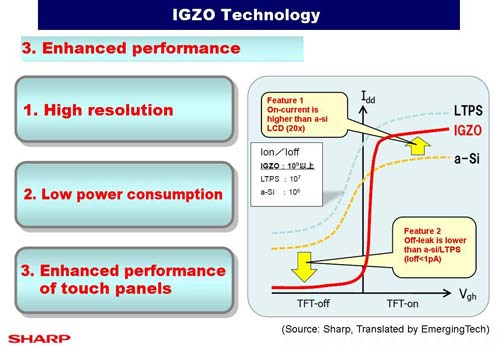
Source: semiconportal.com
In addition to this adaptive refresh rate, the TCON supports panel self-refresh which is hardly news, but given that we’ve seen phones and tablets in this year ship without panel self-refresh it’s worth mentioning.
The panel itself also appears to have dual domain pixels and a conventional RGB stripe. Viewing angles as a result are quite good. The cover glass also contains the AR coating first introduced with the iPad Air 2, which cuts reflectance roughly in half relative to a display that doesn’t have such a coating. This effectively doubles outdoor contrast, so it’s great for outdoor use.
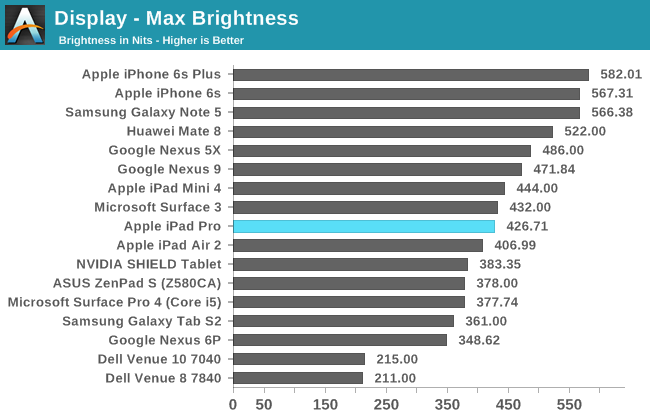
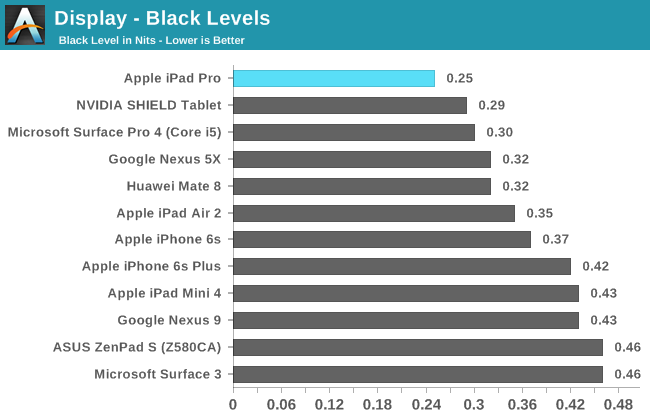
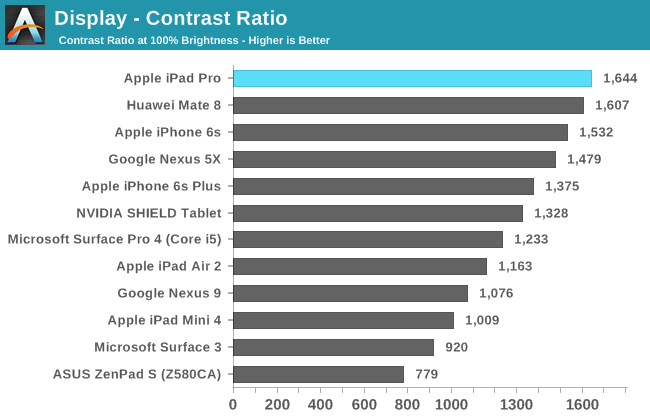
In our standard test of brightness and contrast, it’s evident that Apple has moved to a new generation of display for the iPad Pro as the maximum brightness is mildly improved relative to the iPad Air 2. The real change here though is that contrast is dramatically improved over the iPad Air 2.
This is likely due to the use of photoalignment for the liquid crystals, which helps the liquid crystal to have a more consistent orientation. For those that aren’t really familiar with the particulars of how light polarization and polarizers work, part of the problem is that when a voltage is applied to change the structure of the liquid crystals parts of the liquid crystals won’t necessarily change in structure appropriately. In order to assist with this process a film is applied which gains a particular orientation when exposed to UV light in a specific way. This helps to get the liquid crystals to all align in the same direction, which improves contrast as a result. Of course, contrast isn’t the dark, inky blacks that you'll get with AMOLED but it'll still be quite impressive for normal use.
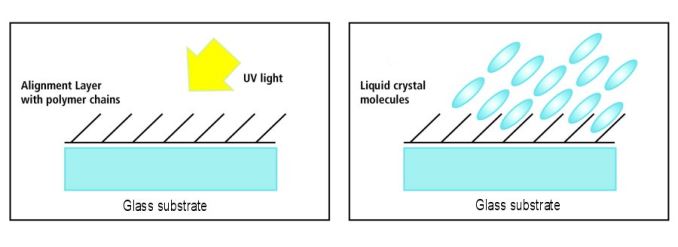 Source: eetimes.com
Source: eetimes.com
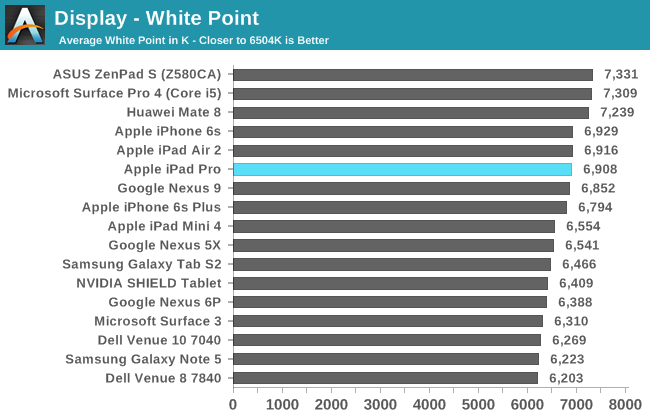
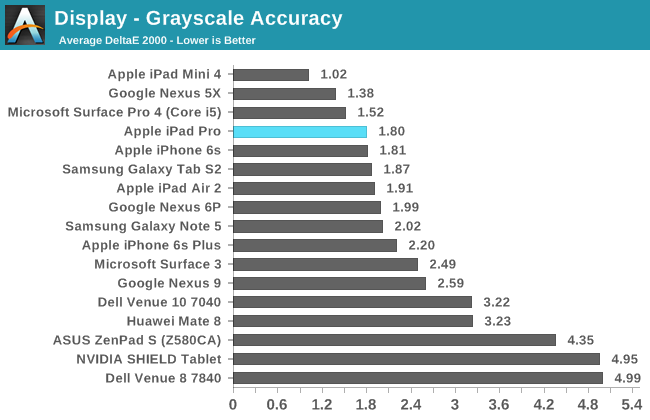
Moving on to our grayscale test, the iPad Pro does impressively well overall with well-controlled gamma but tending slightly towards a colder color balance. I’m not sure whether this is because of backlight efficiency concerns due to the use of blue LED with yellow phosphor in the backlight or because people seem to prefer colder white balances in general, but it’s there nonetheless. The cold color balance might affect some particularly color critical work but even for medical use I suspect it shouldn’t be a serious problem.
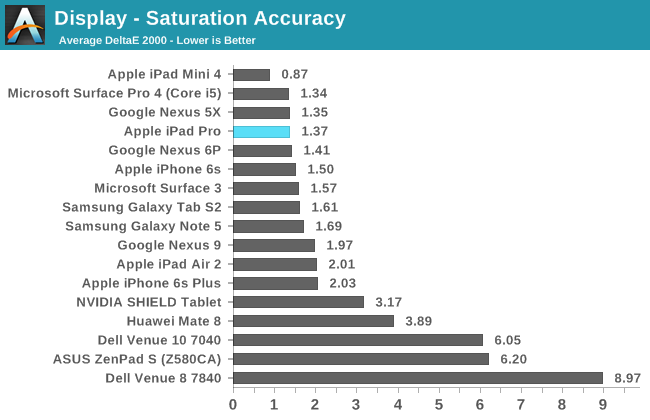
In saturations, the iPad Pro is basically perfect. There is some mild undersaturation of red, but I basically see no reason to try and find some method of personally calibrating the display.
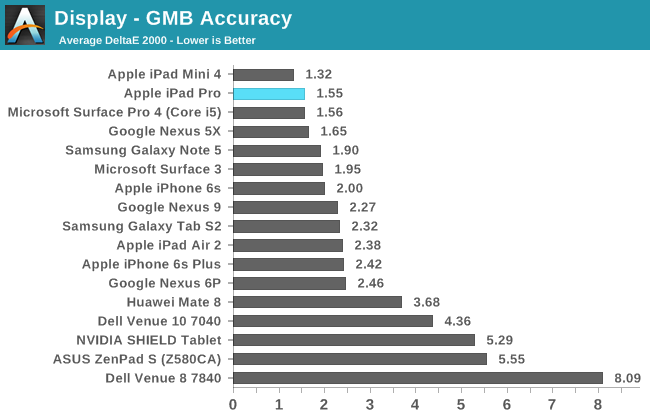
In the Gretag MacBeth ColorChecker test, color error is once again basically nonexistent. Anything with red appears to be mildly undersaturated but the error is going to be almost impossible to notice.
Overall, the iPad Pro display is probably one of the best available on the market today. The Galaxy Tab S2 display is comparable in overall accuracy and has superior contrast, but the iPad Pro has noticeably higher brightness for all content above 50% APL and in any scenario with a lot of ambient background light the AR coating will help a lot with improving effective contrast and general readability. Although pixel density is equivalent to the iPad Air 2, the sheer size of the display means that the viewing distance is increased and therefore the perceived resolution. The display looks great in person, and unless your single point of consideration for display performance is contrast I think it’ll be hard to be disappointed with the iPad Pro display.


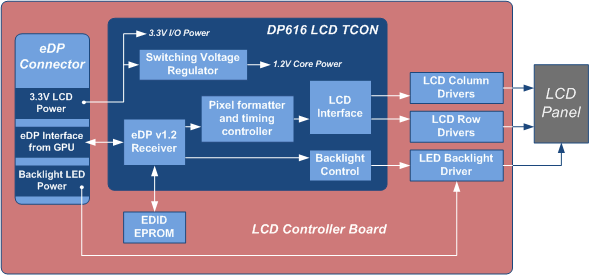


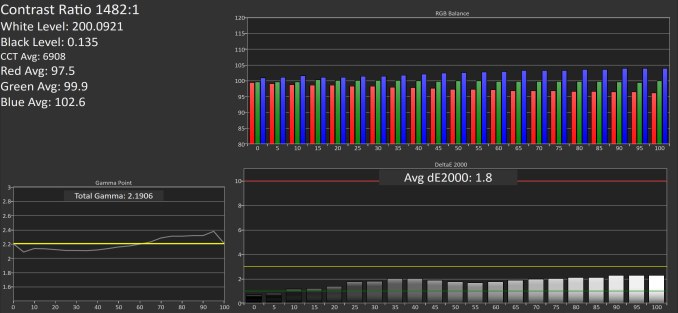
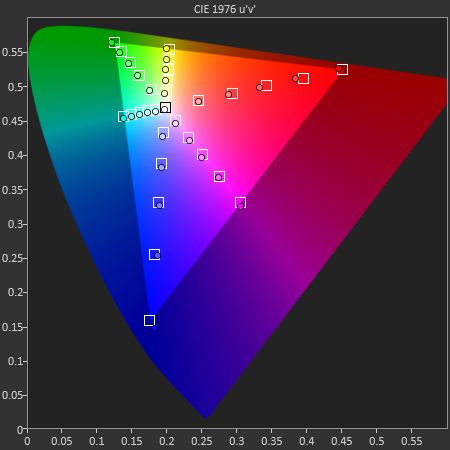
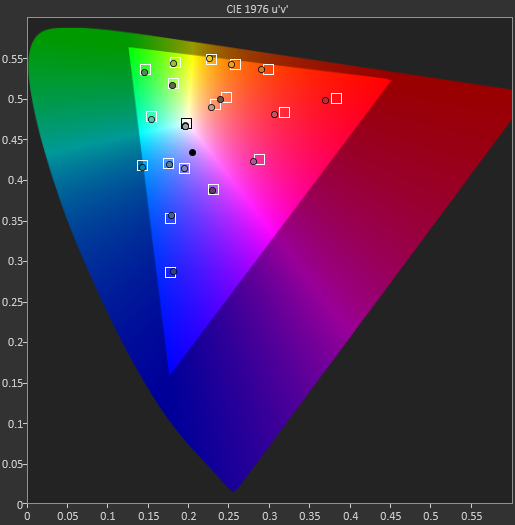








408 Comments
View All Comments
nsteussy - Friday, January 22, 2016 - link
Well said.Wayne Hall - Friday, January 22, 2016 - link
WHAT IS MEANT BY PROFESSIONAL TASKS. I AM THINKING OF THE I-PAD PRO.gw74 - Friday, January 22, 2016 - link
Why do Apple only want content consumers' money in mobile, and not creators' too? Apple are in business to make a profit. If there was money to be made building workstation apps for mobile, it would happen. Furthermore "exploit their owners commercially" is just a pejorative way of saying "sell them stuff in return for money", i.e. "business".Sc0rp - Friday, January 22, 2016 - link
1) Apple made the pencil. I'm sure that they want creator's money too.2) The "Pro" market is incredibly small and fickle.
AnakinG - Friday, January 22, 2016 - link
I think Apple wants people to "think" they are creators and professionals. It's a feel good thing while making money. :)Constructor - Saturday, January 23, 2016 - link
The iPad Pro is a fantastic device for all kind of uses – I personally also use it as a mobile TV, streaming radio (due to its really excellent speakers), game console, internet and magazine reader (since it is pretty much exactly magazine-sized!), drawing board, note pad, multi-purpose communicator (mail, messaging, FaceTime etc.), web reader, ebook reader and so on...As to the numbers: According to an external survey it seems about 12% of all iPads sold in the past quarter were iPad Pros. We're talking about millions of devices there at the scale at which Apple is operating – most other tablet manufacturers and even PC manufacturers would kill for numbers like thes at prices like these!
It's almost funny how some people completely freak out about the iPad Pro because it crashes through their imaginary boundaries between their imaginary "allowed" kinds of devices.
The iPad Pro is a really excellent computer for the desktop (if for whatever reason an even bigger display is not available), which also works really well on my lap (actually much better and almost always more conveniently than a "laptop" computer!) and even in handheld use like a magazine or notepad. It's very light for its size, has a really excellent screen, excellent speakers and is fast and responsive.
Yeah, you can find things which you at this moment can't do on it yet. But there are many, many practically relevant uses at which it excels to a far greater extent than any desktop or notebook computer ever could.
jasonelmore - Sunday, January 24, 2016 - link
so you basically use it as a consumption and a communication device.. our point is, a professional cannot use this as their only computing device. they need PC's or MAC's to supplement it, which all use Intel or AMD.Until this fact changes, intel is far from being in trouble. iPad sales are in a huge slump as well, not just pc sales. Actually, Notebook PC sales are great, its the desktop that slows down every 3-4 years. iPhone is about to become a 0 growth product as well. Apple see's the writing on the wall, and that's why they are exploring cars, and other unknown products. The Chinese market never turned out like they had hoped, with stiff competition at low costs with similar quality.
Constructor - Sunday, January 24, 2016 - link
so you basically use it as a consumption and a communication device..Among many other things! So let me guess, when you happen to play some streaming music on your workplace computer or if you're watching the news on it, does it automatically turn into a "toy" and yourself into one of those mythical "only consumers" as well?
This silly ideology is really ludicrous.
our point is, a professional cannot use this as their only computing device. they need PC's or MAC's to supplement it, which all use Intel or AMD.
Nope.
Some portion of workplaces actually requires a desktop OS. This portion is not 100% but substantially lower than that.
A very large portion of workplaces (likely the majority) could very well use iPads as well, but external circumstances make regular PCs or Macs just more convenient and practical.
And some other portion can and does use mobile devices already now as their primary tools.
The tedious and absurd conclusion from people's own limited knowledge and imagination to absolute judgments of the entire market is anything but new, but it's really old news by now.
Until this fact changes, intel is far from being in trouble. iPad sales are in a huge slump as well, not just pc sales. Actually, Notebook PC sales are great, its the desktop that slows down every 3-4 years. iPhone is about to become a 0 growth product as well. Apple see's the writing on the wall, and that's why they are exploring cars, and other unknown products. The Chinese market never turned out like they had hoped, with stiff competition at low costs with similar quality.
You should seriously get better sources for your information as your imaginations are rather far off from actual reality.
Intel is already in a tightening squeeze between the eroding PC market (especially regarding its crumbling profitability) and the ever-rising development costs they face with their creaking x86 antiquity. That their CPU performance is stagnating at the same time is also increasingly problematic, too, since it puts another damper on the PC market.
When you're talking about Apple you clearly live in a different universe from the rest of us: Apple is actually booming in China while the cheap manufacturers have run into unexpected difficulties against them, and your other imaginations of Apple's doom are neither original nor do they have anything to do with the actual reality on the ground.
Even the iPad is a massive cash cow on a scale the competition can only dream about – it's just dwarfed by the absolute gigantic profits from the iPhone.
But yeah, surely that spells inescapable doom for the company.
Sure!
Coldmode - Friday, January 22, 2016 - link
This is the stupidest paragraph about computing I've ever read. It's equivalent to lamenting Bell's role in telephony because we managed to win World War 1 with telegraphs but now teenagers spend all their time hanging off the kitchen set chatting to one another about their crushes.ABR - Monday, January 25, 2016 - link
@ddriver I disagree with most of what you say in these contents, but, "today we have gigahertz and gigabytes in our pockets, and the best we can do with it is duck face photos," hits the nail on the head! The problem though is not that software developers don't try to do more, but that they can't make any money doing so. The masses just want to buy the latest duck photo app, and there's not enough of the pie left over to support much else. In the early days of the iPad this wasn't so, but nowadays take a look at the top charts in iOS to see what I mean. Games makes more than all others put together, and then even in categories like Utilities, you see mainly Minecraft aids, emoji texters, and a few web browser add-ons. Apple doesn't promote this in their advertising, but they do so in more subtle but effective ways like which apps they choose to feature and promote in the app store. In fact, the store is littered with all kinds of creativity- and productivity-unleashing apps if you search hard, but they all tend to die on the vine because they get swamped out by the latest glossy-image joke-text-photo-video apps and the developer loses interest.